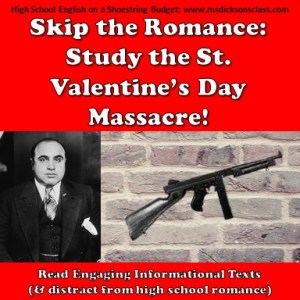Halloween is a bit tricky with the older kids. Many are getting too old (or too cool) for Halloween. But there’s still a chaos in the classroom as the holiday rolls around. Worse if it falls inconveniently during the week.
The sort of Halloween themed worksheets don’t often appeal to the older students. Lame.
But there’s still ways to have some fun with Halloween with activities and literature that fits. Always keep in mind students who don’t celebrate Halloween, or those sensitive to spooky or creepy things.
Below are some fun ideas. Follow the links to my TPT store for related resources.

Read a Creepy short story or poem
Stories like “The Legend of Sleepy Hollow,” “The Raven,” “The Monkey’s Paw,” “The Cask of Amontillado,” or “The Tell-Tale Heart” are great spooky stories without being too scary. Dim the lights if you can. Add a set reading questions, a quiz, and/ or an activity to help kids remember the learning part of the activity. Read or play a dramatic reading that sets the mood.
Tie these spooky stories into larger units, as well.
- “The Raven” can become part of a study on narrator reliability or mad characters. Compare with protagonist husband in “The Birthmark” or “The Cask of Amontillado.”
- “The Monkey’s Paw” is a lot of fun to pair with “Aladdin” to study how wishes are handled in both texts both in number and outcomes.
- “The Legend of Sleepy Hollow” can pair with “Rip Van Winkle” to compare these different American Folklore tales from Washington Irving.

Try some Creative Writing activities
Practice descriptive writing, maybe of a spooky setting. Play some spooky music in the background while they try to capture creepy writing. Find a picture prompt of a creepy or spooky setting as inspiration.
Writing a spooky short story is a common activity. Ghost stories or horror stories make fun writing. Have students attempt foreshadowing, mood, or twist endings in their writing, as these are part of the spooky writing. Students can highlight or annotate their own writing for the literary devices used.
Or a more light-hearted approach is to draw and describe a monster (or beast)– then students trade descriptions. Can they accurately draw what was described? (See the Descriptive Writing is a Beast resource.)

Themed Essay Writing
When a ‘fun’ activity isn’t really an option, there’s always a timely essay topic. Students might write an essay supporting their position on “Do you believe in ghosts?” Another interesting topic is to write an essay on why scary stories are appealing– this can also be paired with the Stephen King Essay “Why we Crave Horror.” The Scary Story Analysis resource has essay instructions and a rubric.
You can also check out the Halloween Themed Essay Writing resource with 1 each expository, narrative, and persuasive essay topics– as well as sub plans and timed essay writing. Like all my Themed Essay Writing, it includes resources for sub plans, timed essay, writing, rubrics for timed/ demand writing and writing process essays.

Watch a short film– bonus if comparing to a text
One of my favorite short films to show is the Disney version of “The Legend of Sleepy Hollow.” Pairs great with the text, but is also a fun short film on its own. Students can write up a Movie vs. Book Comparison (see also the handy resource for Sleepy Hollow specific version). While the story is a ghost story, it’s presented in a goofy way (literally, since the character Goofy is Ichabod Crane).
Or analyze a film as a ‘text’ itself such as with a Movie Literary Analysis. It’s helpful to practice literary analysis, and using a movie as a text can make the process feel fresh and interesting. Can students find literary elements like foreshadowing, use of setting, or unreliable narrator in the movie or movie segment.
Just for Fun
Students can design a literary themed trunk-or-treat or doorway decoration. Or design a literary costume of a character or for a character.
Students can complete the Villainous Words Word Search (Free!) with a list of 39 fun villainous terms related to being despicable, disreputable, or odious.



























